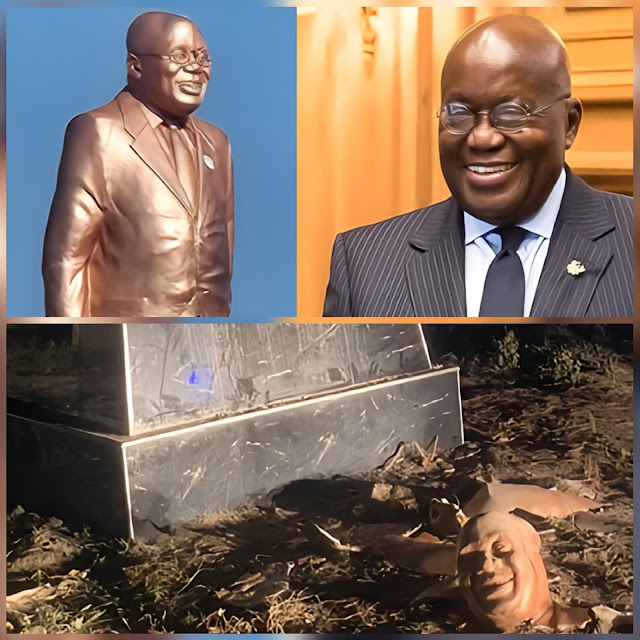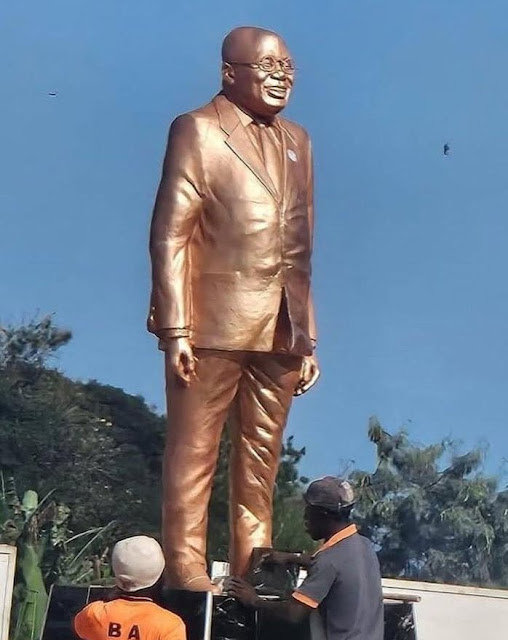- Get link
- X
- Other Apps
- Get link
- X
- Other Apps
In the heart of Sekondi-Takoradi, a city in Ghana's Western Region, a monument meant to honor former President Nana Akufo-Addo has become the center of a contentious debate following its sudden vandalism. The statue, erected at the Effia-Nkwanta Regional Hospital, was intended to commemorate Akufo-Addo's contributions to the area, but its destruction barely two months after its unveiling in November 2024 has ignited a firestorm of public discourse.
The unveiling of the statue was met with significant backlash from the outset. Critics argued that the gesture was premature, especially given the backdrop of several unfulfilled infrastructure projects in the region. The Effia-Nkwanta Regional Hospital, where the statue stood, was one of the projects highlighted during Akufo-Addo's tenure, yet its completion and operational capacity have been points of contention. Many questioned the rationale behind honoring a leader with a statue while basic public services and promised developments remained incomplete or below expectations.
The act of vandalism itself speaks volumes about the polarized views within Ghanaian society regarding leadership, legacy, and the use of public funds for such symbols. The statue's destruction was not just an act of physical defacement but also a symbolic protest against what some perceive as misplaced priorities. In a country where economic issues, healthcare, and infrastructure are pressing concerns, the erection of a statue to a former president seemed to some as an unnecessary luxury, or worse, an act of self-aggrandizement.
Public reactions have varied widely. On one side, there are those who decry the vandalism as an act of lawlessness, disrespect, and a direct affront to the values of peace and respect for public property. They argue that regardless of one's political stance, the destruction of any public monument is a step backward in civic behavior and national unity. These voices call for the swift apprehension of those responsible, emphasizing the need for law and order.
On the flip side, others see the vandalism as a form of political expression or even a justified act of public dissent. They argue that the statue was not just a piece of art but a political statement in concrete form, one that was not universally welcomed. For them, the destruction might be interpreted as a community's way of voicing frustration over unfulfilled promises or as a critique of political leadership that they feel has not served their interests well. This perspective sees the incident as part of a broader discourse on how leaders should be commemorated and when it's appropriate to do so.
The police have launched an investigation, indicating the seriousness with which the government views the incident. This response underscores the legal implications of such acts, potentially setting a precedent for how similar future events might be handled. However, beyond the immediate legal discourse, this event has reopened conversations about the role of monuments in society. Are they meant to celebrate achievements, or do they risk becoming points of contention, especially when the public's perception of a leader's legacy is divided?
Moreover, this incident has sparked a debate on the allocation of public funds. In a country where every cedi counts towards development, the cost of erecting statues, particularly of living or recently retired leaders, is under scrutiny. There's a growing call for more transparent decision-making regarding public monuments, suggesting perhaps a public consensus or at least a more inclusive process before such decisions are made.
read also: Nigerian Fashion Designer Veekee James Under Fire for "Lowering Standards" Comment
In essence, the destruction of Nana Akufo-Addo's statue in Sekondi-Takoradi is more than an act of vandalism; it's a reflection of deeper societal issues around leadership, accountability, and public memory. It illustrates how symbols meant to unite can instead become focal points for division, showing the delicate balance between honoring leaders and respecting the public's voice. As the dust settles, the real question remains—how do societies reconcile the celebration of leaders with the lived experiences of their citizens? This event might just be a catalyst for that conversation in Ghana, pushing for a reevaluation of how we choose to remember our leaders in stone and bronze.



.jpeg)


.jpeg)
Comments
Post a Comment